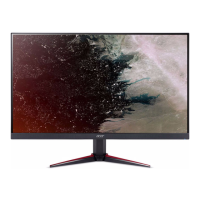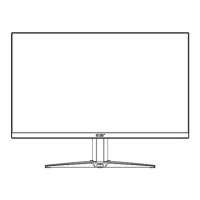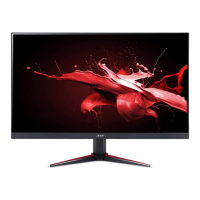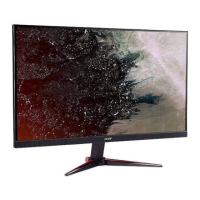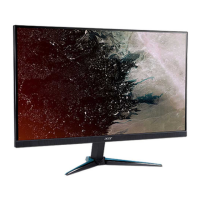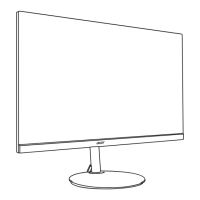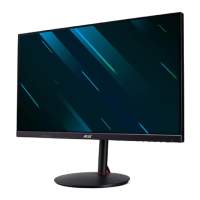Do you have a question about the Acer Nitro VG240Y Series and is the answer not in the manual?
Read and follow all safety warnings and instructions provided for the monitor.
Details common phenomena with LCD monitors that do not indicate a problem.
Guidelines for safely cleaning the monitor screen and cabinet.
Ensures power outlet accessibility and provides instructions for safe audio usage.
Important safety warnings regarding product placement, ventilation, and liquid exposure.
Guidance on power connection, extension cords, and when to seek professional repair.
Precautions for explosive atmospheres, small parts, and recycling/disposal.
Advice on comfortable use, posture, eyestrain prevention, and workspace habits.
Tips to make computer use more relaxing and productive through breaks and exercise.
Check that all items are present when unpacking the box and save packing materials.
Lists VESA modes, resolutions, and refresh rates supported by the monitor.
Step-by-step guide for connecting the monitor to a computer and power.
Enables dynamic adjustment of display refresh rate for smoother visuals.
Identifies the monitor's buttons and their primary functions.
Details the functions of the power button and navigation keys.
Guide to opening and navigating the On-Screen Display (OSD) menus.
How to choose the video input source (HDMI, VGA, Auto).
Navigating and adjusting settings within the monitor's OSD Function page.
Adjusting Brightness, Contrast, Black Boost, Blue Light, ACM, and Super Sharpness.
Adjusting color parameters, gamma, and audio volume/mute.
Configuring Over Drive, FreeSync, MPRT, and Aim Point for gaming.
Adjusting OSD language, timeout, transparency, and system configurations.
Saving custom settings to user-defined profiles for future recall.
Guidance for self-diagnosing and resolving common display issues.
Read and follow all safety warnings and instructions provided for the monitor.
Details common phenomena with LCD monitors that do not indicate a problem.
Guidelines for safely cleaning the monitor screen and cabinet.
Ensures power outlet accessibility and provides instructions for safe audio usage.
Important safety warnings regarding product placement, ventilation, and liquid exposure.
Guidance on power connection, extension cords, and when to seek professional repair.
Precautions for explosive atmospheres, small parts, and recycling/disposal.
Advice on comfortable use, posture, eyestrain prevention, and workspace habits.
Tips to make computer use more relaxing and productive through breaks and exercise.
Check that all items are present when unpacking the box and save packing materials.
Lists VESA modes, resolutions, and refresh rates supported by the monitor.
Step-by-step guide for connecting the monitor to a computer and power.
Enables dynamic adjustment of display refresh rate for smoother visuals.
Identifies the monitor's buttons and their primary functions.
Details the functions of the power button and navigation keys.
Guide to opening and navigating the On-Screen Display (OSD) menus.
How to choose the video input source (HDMI, VGA, Auto).
Navigating and adjusting settings within the monitor's OSD Function page.
Adjusting Brightness, Contrast, Black Boost, Blue Light, ACM, and Super Sharpness.
Adjusting color parameters, gamma, and audio volume/mute.
Configuring Over Drive, FreeSync, MPRT, and Aim Point for gaming.
Adjusting OSD language, timeout, transparency, and system configurations.
Saving custom settings to user-defined profiles for future recall.
Guidance for self-diagnosing and resolving common display issues.
This is a user guide for an Acer LCD monitor, designed to provide visual display of information from electronic devices. It covers safety instructions, special notes on LCD monitors, cleaning procedures, accessibility, safe listening practices, warnings, electrical power usage, product servicing, potentially explosive environments, additional safety information, IT equipment recycling information, disposal instructions, LCD pixel statement, tips for comfortable use, finding your comfort zone, taking care of vision, developing good work habits, and declarations of conformity.
The Acer LCD monitor serves as a visual output device for electronic systems. It supports various display modes and resolutions, including VGA, MAC, SVGA, XGA, SXGA, WXGA, WSXGA+, and UXGA, with refresh rates ranging from 56Hz to 75Hz. The monitor is designed to be plug-and-play, automatically communicating its capabilities to the host system via the DDC (Display Data Channel) protocol. It supports DDC2B standard. The monitor can be connected via HDMI 1.4, VGA, or DisplayPort (DP) cables, and some models also support audio input. It features power-saving modes, indicated by an amber-colored power LED, which activate when the display controller sends a control signal. The monitor can dynamically adjust its refresh rate based on content frame rates for power efficiency, stutter-free, and low-latency display updates, especially with FreeSync-supported graphics sources.
The monitor offers a range of user controls and adjustments to optimize the viewing experience.
| Screen Size | 23.8 inches |
|---|---|
| Resolution | 1920 x 1080 (Full HD) |
| Panel Type | IPS |
| Refresh Rate | 75Hz |
| Response Time | 1ms (VRB) |
| Aspect Ratio | 16:9 |
| Brightness | 250 cd/m² |
| Contrast Ratio | 1000:1 |
| Adaptive Sync | AMD FreeSync |
| Viewing Angle | 178° (H) / 178° (V) |
| Color Gamut | 72% NTSC |
| VESA Mount | 100 x 100 mm |
| Tilt Angle | -5° to 15° |
| Ports | 1 x HDMI, 1 x VGA |
